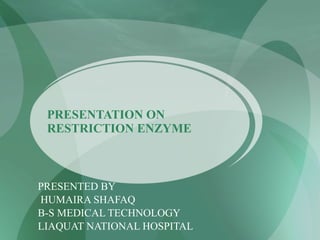
presenatationonrestrictionenzyme-100407150234-phpapp02 (1).pdf
- 1. PRESENTATION ON RESTRICTION ENZYME PRESENTED BY HUMAIRA SHAFAQ B-S MEDICAL TECHNOLOGY LIAQUAT NATIONAL HOSPITAL
- 2. WHAT IS AN ENZYME? • Enzymes are proteins and certain class of RNA (ribozymes) which enhance the rate of a thermodynamically feasible reaction and are not permanently altered in the process.
- 3. MOLECULAR SCISSORS Restriction enzymes are molecular scissors
- 4. RESTRICTION ENZYMES • A restriction enzyme (or restriction endonuclease) is an enzyme that cuts double-stranded or single stranded DNA at specific recognition nucleotide sequences known as restriction sites.
- 5. HISTORY OF RESTRICTION ENZYME • First restriction enzyme was isoltaed in 1970 by Hindll. • He also done the the subsequent discovery and characterization of numerous restriction endonucleases. • From then Over 3000 restriction enzymes have been studied in detail, and more than 600 of these are available commercially and are routinely used for DNA modification and manipulation in laboratories
- 6. HOW RESTRICTION ENZYMES WORKS? • Restriction enzymes recognize a specific sequence of nucleotides, and produce a double-stranded cut in the DNA. these cuts are of two types: • BLUNT ENDS. • STICKY ENDS.
- 8. BLUNT ENDS • These blunt ended fragments can be joined to any other DNA fragment with blunt ends. • Enzymes useful for certain types of DNA cloning experiments
- 9. “STICKY ENDS” ARE USEFUL DNA fragments with complimentary sticky ends can be combined to create new molecules which allows the creation and manipulation of DNA sequences from different sources.
- 10. • While recognition sequences vary widely , with lengths between 4 and 8 nucleotides, many of them are palindromic.
- 11. PALINDROMES IN DNA SEQUENCES Genetic palindromes are similar to verbal palindromes. A palindromic sequence in DNA is one in which the 5’ to 3’ base pair sequence is identical on both strands (the 5’ and 3’ ends refers to the chemical structure of the DNA).
- 12. NOMENCLATURE OF RESTRICTION ENZYME • Each enzyme is named after the bacterium from which it was isolated using a naming system based on bacterial genus, species and strain. For e.g EcoRI order of identification in the bacterium First identified I strain RY13 R species coli co genus Escherichia E Description Meaning Abbreviation Derivation of the EcoRI name
- 13. TYPES OF RESTRICTION ENZYMES • Restriction endonucleases are categorized into three general groups. • Type I • Type II • Type III
- 14. CONTINUE… • These types are categorization based on: Their composition. Enzyme co-factor requirement. the nature of their target sequence. position of their DNA cleavage site relative to the target sequence.
- 15. TYPE I INTRODUCTION • Type I restriction enzymes were the first to be identified and are characteristic of two different strains (K-12 and B) of E. coli. • The recognition site is asymmetrical and is composed of two portions – one containing 3-4 nucleotides, and another containing 4-5 nucleotides – separated by a spacer of about 6-8 nucleotides.
- 16. COFACTORS OF TYPE I • Several enzyme cofactors include: S-Adenosyl methionine. Hydrolyzed adenosine triphosphate (ATP). Magnesium (Mg2+).
- 17. SUBUNITS OF TYPE I • Type I restriction enzymes possess three subunits: o HsdR: is required for restriction. o HsdM: necessary for adding methyl groups to host DNA (methyltransferase activity). o HsdS: important for specificity of cut site recognition in addition to its methyltransferase activity.
- 18. TYPE II • These are the most commonly available and used restriction enzymes • They are composed of only one subunit. • Their recognition sites are usually undivided and palindromic and 4-8 nucleotides in length, they recognize and cleave DNA at the same site. • They do not use ATP or AdoMet for their activity – they usually require only Mg2+ as a cofactor.
- 19. CUTS OF TYPE II • Type II restriction enzymes can generate two different types of cuts depending on whether they cut both strands at the centre of the recognition sequence: • The former cut will generate “blunt ends” with no nucleotide overhangs. • The latter, generates “sticky” or “cohesive” ends
- 20. SUBGROUPS OF TYPE II • These subgroups are defined using a letter suffix. Type IIB restriction enzymes. Type IIE restriction endonucleases. Type IIM restriction endonucleases. Type IIT restriction enzymes
- 21. TYPE III • Type III restriction enzymes ) recognize two separate non-palindromic sequences that are inversely oriented. • They cut DNA about 20-30 base pairs after the recognition site. • These enzymes contain more than one subunit. • And require AdoMet and ATP cofactors for their roles in DNA methylation and restriction
- 22. APPLICATION OF RESTRICTION ENZYMES • They are used in gene cloning and protein expression experiments. • Restriction enzymes are used in biotechnology to cut DNA into smaller strands in order to study fragment length differences among individuals (Restriction Fragment Length Polymorphism – RFLP). • Each of these methods depends on the use of agarose gel electrophoresis for separation of the DNA fragments.